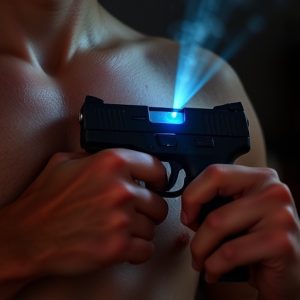Decoding Stun Gun Voltage: The Science of Effectiveness and Skin Contact
Stun guns are non-lethal self-defense devices that use high-voltage, low-ampere electrical shocks t…….
Stun guns are non-lethal self-defense devices that use high-voltage, low-ampere electrical shocks to incapacitate attackers. Contrary to some misconceptions, they do not always require direct skin contact to be effective due to their "contact electricity" mechanism. The effectiveness of a stun gun is influenced by its voltage, current, electrode design, and the resistance between the probes and the target. Advanced models can penetrate through clothing to varying degrees, with some capable of a "drive stun" function that allows them to deliver a shock without direct contact. For optimal performance, users should aim to minimize the distance between the probes and the target, as this increases the likelihood of an effective incapacitating effect. Understanding these factors, including the discharge cycle duration and the type of circuitry, is essential for anyone considering a stun gun for personal safety. It's important to note that real-life effectiveness can vary due to factors like the target's physiology, environmental conditions, and potential electronic interference. Thus, users should familiarize themselves with how their chosen model operates under different circumstances to ensure its effectiveness when needed.
When considering personal safety devices, the effectiveness of stun guns often hinges on their voltage output. This article delves into the pivotal role of voltage in stun gun performance and addresses the common query: “Does a stun gun have to touch skin to be effective?” We’ll explore the scientific principles that make stun guns a deterrent, assess the impact of voltage levels on their stopping power, and consider factors beyond voltage that can influence their efficacy. Additionally, we’ll provide practical guidance on maximizing the effectiveness of stun guns in self-defense scenarios. Join us as we unravel the intricacies behind the science and application of stun gun voltage for optimal safety and security.
Understanding Stun Gun Voltage: The Science Behind Effectiveness
Stun guns are electronic devices designed to incapacitate an assailant by delivering a high-voltage, low-current electrical shock. The effectiveness of a stun gun is largely determined by its voltage output and the electrodes’ ability to create an effective circuit between them upon contact with an individual. Contrary to a common belief that a stun gun must directly touch skin to be effective, certain models are designed to deliver an shock through clothing, although the intensity of the effect may vary depending on the thickness and conductivity of the barrier.
The voltage of a stun gun is a critical factor in its incapacitating power. High voltage is necessary to create a strong enough electrical field that disrupts muscle function and causes neuromuscular involuntary contractions, effectively immobilizing an attacker. The science behind this phenomenon involves the principles of electrophysiology, where the electric current interferes with the electrical signals in the nervous system. While the threshold voltage required to produce an uncomfortable sensation without causing injury is relatively low, the voltage range that can incapacitate a person by inducing muscle spasms and disorientation is higher, typically ranging from 30,000 to 50,000 volts in consumer stun guns. It’s important for users to understand that the actual effectiveness of a stun gun during a confrontation can be influenced by factors such as the individual’s size, muscle mass, hydration levels, and any potential interference from environmental conditions or electronic devices carried by the target or the user.
The Role of Voltage in Stun Guns: What Levels are Most Effective?
Stun guns are self-defense tools that incapacitate an assailant by delivering a high-voltage, low-ampere electrical charge. The effectiveness of a stun gun is primarily tied to its voltage output. Voltage is a critical factor as it influences the device’s ability to create a strong enough electrical current to disrupt the muscle control of an attacker. Typically, stun guns operate at various voltage levels, ranging from as low as 400,000 volts to over 1 million volts. The higher the voltage, the greater the potential for effectiveness.
However, it’s a common misconception that a stun gun must make direct contact with the skin to be effective. While contact is necessary to deliver the electrical shock, modern stun guns are designed with electrode probes that can deliver the charge through clothing in many cases. The key is that the electrical current needs to reach the muscle tissue for the device to be effective. A common question regarding their use is “does a stun gun have to touch skin?” The answer lies in the design of the probe and the insulating properties of the barrier between the probes and the skin. For instance, a thick leather jacket may prevent the current from reaching its intended target, whereas a thin layer of clothing generally will not. Users should be aware that factors such as moisture, the surface area of contact, and the resistance of the barrier can influence the effectiveness of the stun gun when it does not make direct skin contact. Understanding these variables is crucial for users to operate the device with confidence in various situations.
Does a Stun Gun Have to Touch Skin to be Effective? Analyzing Contact Electricity
Stun guns are non-lethal self-defense devices that incapacitate attackers through an electrified delivery system. A common question regarding their use is whether they must make direct contact with an individual to be effective. The answer lies in the mechanism of a stun gun’s operation. When activated, a stun gun emits a high-voltage, low-ampere electrical charge. This charge, often referred to as “contact electricity,” can jump across a small gap, which means the device does not necessarily have to adhere directly to the skin to be effective. The effectiveness of the shock is influenced by factors such as the distance between the probes and the resistance of the air gap. Typically, for the electricity to be most effective, the probes should be within an inch or two of the target area. However, the voltage of the stun gun is a critical component in its ability to leap the space between the device and the person. Higher voltages increase the likelihood of the electric current jumping the gap, thereby making contact less of a strict requirement for the stun gun to deliver an incapacitating shock. It’s important to note that while the electricity can jump a small distance, the further the probes are from the body, the less effective the stun gun may be. Users should aim to bridge as much of that gap as safely possible to ensure the device operates as intended.
Factors Influencing Stun Gun Performance Beyond Voltage
Stun guns are often evaluated primarily on their voltage output, but there are several other critical factors that influence their effectiveness in incapacitating an assailant. Beyond voltage, the current delivered by a stun gun is a significant determinant of its stopping power. A higher amperage can increase muscle contractions and neuromuscular incapacitation, which are essential for self-defense. Moreover, the design and configuration of the electrode probes play a vital role; pointed or spongy probes can penetrate clothing more effectively, allowing the device to deliver its charge even if it does not directly touch skin. The resistance between the probes and the target also affects performance, with lower resistances resulting in more efficient energy transfer.
Another influential factor is the duration of the stun gun’s discharge cycle. A longer cycle can increase the effectiveness by continuing to stimulate the muscles beyond a single shock, which can be particularly advantageous if the initial shock is not immediately incapacitating. Additionally, the type of circuitry used in the device—capacitor-based or battery-powered muscle stimulators—can impact its efficiency and reliability under different conditions. Lastly, user training and technique are paramount; proper aiming, application force, and contact time can greatly enhance a stun gun’s effectiveness. Understanding these factors is crucial for users to effectively utilize stun guns in self-defense situations, as their performance goes beyond the voltage specification alone.
Practical Considerations for Stun Gun Usage: A Guide to Maximizing Effectiveness in Self-Defense Situations
When considering the effectiveness of a stun gun for self-defense, understanding its operation and limitations is crucial. A stun gun’s voltage is a significant factor in its ability to incapacitate an attacker; however, it’s a common misconception that a higher voltage automatically translates to greater effectiveness. In reality, the amount of voltage required to be effective can vary based on several factors, including the individual’s physiology and environmental conditions. It’s important to choose a stun gun with an appropriate voltage for your needs; many models range from 50,000 to over 1 million volts.
Moreover, the question of whether a stun gun has to touch skin to be effective is one that potential users often have. While it is most effective when contact is made directly with the assailant’s body, modern stun guns come equipped with drive stun capabilities and other features like “drive stun” which can deliver a powerful electric shock even without a direct skin contact. This feature allows for a disorienting electrical charge to be administered from a distance or through clothing. When selecting a stun gun, consider models that offer this functionality for situations where maintaining personal space is critical. Additionally, ensure you are familiar with the device’s operation, as practice and knowledge of its use can significantly impact its effectiveness in a self-defense scenario.


